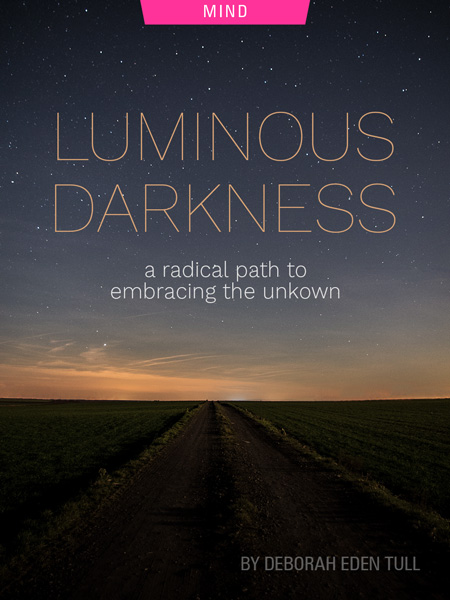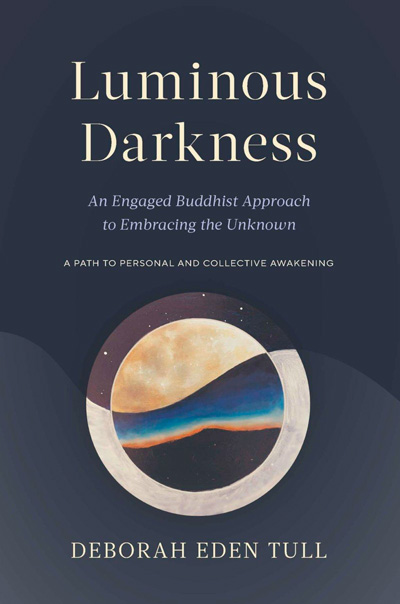Estimated reading time: 9 minutes
Reframing our relationship to darkness can help us see it as a benevolent spiritual teacher and avail us of a limitless field of possibility
—
So many of us have been taught to fear the dark, the unknown, the unwanted, the unfamiliar. When the terrain we’re standing on feels unstable or wobbly, our conditioned tendency is to try to get back to seemingly solid ground, the familiar, the light, that which we can label and rationally understand. Yet no matter who we are, being human is filled with uncertainty…and together we are facing a time collectively of unprecedented change and global uncertainty.
So, what can darkness teach us?
When we recognize that spiritual growth is about letting go entirely of the familiar shore, without yet seeing the next shore, in order to open to something more…we open our hearts to the luminous darkness. What do I mean by darkness? Darkness is not the absence of light, but something deeper…more elemental. Think of darkness as the field of all possibility. The mystery from which we all come and to which we will all return. The fertile spaciousness that is the backdrop of every moment. The unformed. Unseen. Invisible. Emergent. The yin restorative aspect of nature and consciousness.
Consider the life experiences you may have had recognizing the teacher of darkness.
Perhaps you’ve learned to embrace more of who you are, through listening to and welcoming the deeper darker undercurrents of your internal experience. Perhaps you’ve experienced a “dark night,” a time when an illness or life change turned things upside down but simultaneously opened your heart in such a way that has never since been closed. Maybe you’ve learned to listen to and trust your inner compass through having to navigate the groundless unknown. Or perhaps you’ve recognized the teacher of darkness through practices of slowing down, and mindfully pausing from the busy human world. As meditation teaches us, simply by surrendering to presence, we remember the dark, receptive aspect of being as the seat of authentic power.
Wisdom traditions, across the globe throughout history, have recognized the teacher of darkness as an instigator of spiritual growth. But in today’s world of bright artificial lights, speed, and the rational mind, we seem to have forgotten the wisdom of darkness. I believe we all crave the deeply restorative message that darkness can provide us. I believe we’re tired of this habit of pushing away one half of our human experience. I feel for all of us in this age of change…and want with all my heart for humanity to learn to navigate the unknown with Wisdom. Compassion. Clear Seeing.
I sense, in the unrelenting disruption of our times, a collective call to re-learn, to journey through the dark, to deeply listen, sense, attune, and feel our way through the unknown — rather than to fear it.
I spent the first year of the global pandemic finishing a new book, Luminous Darkness: An Engaged Buddhist Approach to Embracing the Unknown. While I was at first resistant to the calling I felt to write about darkness, I recognized the undeniable importance of this topic for all of us in these times. Through decades of spiritual practice and activism, seven years spent as a Zen Buddhist monastic, time immersed in animism and shadow work, and one who has navigated illness and loss, I’ve come to perceive darkness as a benevolent spiritual teacher. A powerful guide paving a radical path to wholeness.
It is in meeting the unknown that we remember the wisdom of our bodies beyond the rational mind. It is in befriending the night — physically and metaphorically — that we remember an inner strength more steadfast than we’re aware of. It is by learning to rest in the mind of “I don’t know” that we can awaken to a relational intelligence that includes the entire cosmos.
It is through turning towards, rather than away, from what we label dark within ourselves that the sacred messenger of shadow gets revealed.
Here is an excerpt from Luminous Darkness:
From Luminous Darkness: An Engaged Buddhist Approach to Embracing the Unknown by Deborah Eden Tull © 2022 by Deborah Eden Tull. Reprinted in arrangement with Shambhala Publications, Inc. Boulder, CO. www.shambhala.com
[pg. 15–18]
Redefining Darkness
I live in the lush, dense, dark, temperate rainforest of Western North Carolina. In the spring and summer, when the mountains explode with the green of trees, ferns, herbs, fungi, and flowers, my husband and I enjoy exploring the deep off-trail woods. There is no known direction as we walk. No set human-created path to follow. We let our intuitions guide us, or we find a meandering creek to lead the way. The forest is wildly dynamic, pregnant with life, and we walk, barefoot, among leaves, pine needles, rocks, earth, and wet marsh. We move slowly and with care, guided by curiosity, wonder, and body awareness. The terrain is a balance of nocturnal shade contrasted with patches of golden sunlight bursting with photosynthesis. The forest expresses nature’s stillness and complexity, harmony and chaos, in perfect balance. Linear time dissolves as we then rest for what seems like hours under the sheltering shade of the trees.
Walking off-trail through a dense forest is the metaphor I will use for our journey into endarkenment. There is no existing human-made trail for understanding darkness. A brightly lit path with signs pointing out the direction will never allow us to sense and feel our way into the mystery itself. Additionally, everyone’s journey will be different and unique.
The forest wilderness is a metaphor for both the spiritual journey and our collective journey through today’s global uncertainty.
We can no longer rely on our existing orientation to guide us. The challenges we face call for the development of new relational forms of knowing and navigation. The forms we seek, however, already exist within each of us.
Like a thicketed forest, the terrain of darkness can only be traversed by sensing, feeling, inquiring, and listening with our whole bodies, being both curious and humble at the same time. A dissertation that “sheds light” on darkness would merely offer a path into the light or the known. The creative challenge for me as a dharma teacher and writer is to invite you into an embodied exploration.
For those of you who are wondering, What is endarkenment? What exactly do you mean by darkness? I will soon offer definitions and propose fresh ways of perceiving darkness. By so doing, I will encourage the spirit of possibility rather than conclusion.
The architecture of this book will invite you to question your existing associations with darkness—both physical and metaphorical. We will explore some of the emotional, psychological, spiritual, and ecological repercussions of rejecting darkness. We will then invoke the spiritual teachings revealed by divine darkness, ultimately embracing an expansively larger perspective where dark and light exist in partnership within ourselves and our world. Finally, I will explore the inspiring invitation that endarkenment offers as we face unprecedented global change. I encourage you to let each chapter open your perception to different and fresh dimensions of what darkness is.
The first step to understanding endarkenment is to become curious about darkness beyond your familiar associations. Be open to what you don’t know that you don’t know . . . about darkness and light, about yourself, about the mystery itself. We can learn to meet the unknown and the experience of not knowing with an open and humble heart, much more full of wonder and willingness than fear.
Endarkenment celebrates 5 aspects of embodied meditation and spirituality:
1. Our awakening through embodiment and earth connection. Only by bringing our awareness down into our bodies and affirming our connection with the earth, away from the realm of concepts and ideas, do we remember who we really are.
2. The restoration of our ability to see clearly with the heart by surrendering to receptivity and by taking responsibility for the lens through which we are perceiving. I am not referring solely to the organ of the heart, though it’s an extraordinary organ of relational intelligence. I am speaking of the heart of our beings, the sacred integration of body-heart-mind accessed through meditation.
3. The reclamation of our true nature or original consciousness by releasing hierarchical perception. All hierarchical thinking is a distortion in consciousness, as I will explore in this book. There is no exception. Hierarchy was invented by humankind, and it has been passed down through the generations.
4. The deepening of our relationship with ourselves and others and our intercommunicative relationship with nature, the visible and invisible matrix of life. Endarkenment invites us into multinatural awareness, interbeing through pathways for communication and collaboration with life. These pathways already exist within our bodies. While earth-based and animistic traditions have celebrated multinatural awareness throughout history, contemporary society is limited by a human-centered and technology-centered paradigm.
5. The willingness to meet all life—including shadows—with fierce compassion. Embodied meditation embraces all aspects of our humanity, rather than trying to transcend dark to get to the light.
* * *
Experiential Practice: Meeting Darkness
Please prepare to pause and close your eyes for a few minutes. Set the intention, with eyes closed, to take in a few deep, conscious breaths. Feel the air as it enters your body, fills your body, and leaves your body. Be aware of your body’s connection to gravity and sense the earth beneath you. Once you have settled into darkened stillness, notice with curiosity what is moving through your internal landscape. Go slowly . . . noticing your body, mind, and feelings.
When you are ready, keep your eyes closed and become aware of the outer landscape of sound, temperature, and the way the space you are in feels.
Then, continue to remain in the darkened stillness and allow yourself to become aware of the inner and outer landscapes at the same time.
Notice how, void of visual perception, all of your other senses awaken. In the darkness, our perception opens beyond our habitual visual orientation to life.
—
If we’re willing to question our assumptions about what darkness is and instead open up to its radiant invitation, new but ancient pathways for understanding can unfurl within us.
In my own life journey, it has been the darkness that has nourished me to bloom, to flourish, to embrace the full spectrum of my experience, and to reclaim the wholeness that cannot be accessed by reaching only to the light.
Like dark soil protects a germinating seed…or the dark cocoon tenderly holds the caterpillar in metamorphosis…it is darkness that invokes the dreamer within to emerge and guide us beyond the mind of limitation and separation.
To join me in exploring Luminous Darkness or learn more about my new book, connect with me online: E-mail | Website | Instagram | Facebook | Youtube
Click here to donate to Mindful Living Revolution via Paypal
You may also enjoy reading Lost and Found: Bewilderment as an Invitation to Transformation, by Jeffrey Davis.

